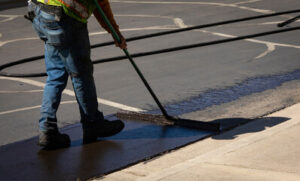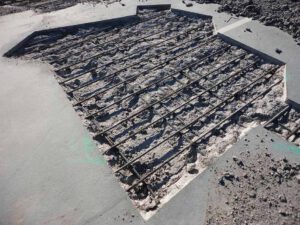Sealcoating is a crucial part of asphalt maintenance. It helps extend the life of your blacktop surface and enhances your property’s appearance.

It is essential to understand how to properly prepare, mix, and apply a quality seal coat for maximum results. First, workers should wear adequate personal protective equipment.
Sealcoating is a process of applying a coating to the surface of asphalt to protect it from damage and make it look newer. It helps to protect the pavement from the elements, chemicals, and oil spills that degrade the asphalt. It is important to apply a new layer of sealcoat every few years to keep the pavement looking good and functioning properly.
Before you can apply the sealcoat, it is essential to clean the pavement. This should include removing any weeds, grease, or oil spots from the asphalt. You can do this with a power washer or by hand using a stiff brush. In addition, the area should be completely dry before applying the sealcoat. This will ensure the quality of the work and help the sealcoat to stick.
If you are sealing your commercial parking lot, it is a good idea to communicate with customers and business partners about the site being inaccessible for several hours while the sealcoat dries. This will ensure that nothing is disrupted during the process and that the sealcoat has a chance to fully cure before vehicles are allowed back on the site.
In addition, you should assess the area to determine if it needs any repairs before proceeding with sealcoating. This may include repairing cracks, filling potholes, and replacing severely damaged areas of the pavement. It is also a good time to repair any catch basins, drainage grates, or drain tiles that are damaged.
After the repairs are made, the blacktop should be thoroughly cleaned with a broom or air broom to remove any dirt and debris that is left on the pavement. This will ensure that the sealcoat adheres well to the blacktop and that it looks clean once it is dry.
It is also a good idea to remove any signage from the pavement, as this will prevent it from being covered by the sealcoat. Additionally, you should close off the area to pedestrians and vehicles so that they are not in the way of the process. This can be done with cones and barricades if necessary.
Mixing
Sealcoating is a protective coating that preserves asphalt pavement by shielding it from the sun’s damaging UV rays, slowing down the oxidation process, and protecting it from chemical penetration. It also provides a skid-resistant and anti-glare surface for vehicles. Sealcoating is a great way to extend the life of asphalt, and it’s relatively inexpensive. It’s a good idea to get it done every two to three years.
Before you apply the sealcoat, it’s important to make sure that the surface is clean and dry. This will prevent the new coating from sticking. In addition, you’ll need to remove any oil spills, debris or dirt that may be present. You can use a broom, power washer or hose to clean the surface. Once the area is dry, you can start to mix the sealcoat.
It’s important to follow the manufacturer’s instructions when mixing sealcoat. The sand, additives and water should all be mixed in the recommended proportions. The mixer should be agitated for 5 to 10 minutes after all the ingredients have been added. The sand should be of the right grade and consistency to ensure that it will bond well with the asphalt.
There are several different types of additives that can be used in a sealcoat mix. Some are designed to help the material dry faster, while others modify sand suspension or add resistance to salts and petrochemicals. The best type of additive for your needs will depend on the conditions in your area and the specifics of your project.
Another important consideration is the temperature. You’ll want to apply the sealcoat in warm weather so that it will have a chance to cure properly. It’s a good idea to avoid applying sealcoat when it is expected to drop below 50 degrees or when rain is in the forecast.
If you need to apply sealcoat in colder weather, it’s a good idea to apply multiple coats. This will allow the sealcoat to set more quickly, and it’ll be less likely to damage the surface. This will also prolong the life of your sealcoat.
Applying
The purpose of sealcoating is to fill in cracks and chips, slow down the oxidization of asphalt and provide a barrier against harsh weather conditions, chemicals, water, oils, vehicular harm, and U.V. rays. It is a protective layer that, when applied regularly to an asphalt pavement surface, extends its life and appearance significantly.
The sealcoat is composed of a thick liquid mixture containing various additives to enhance its performance. These additives may help in drying the sealcoat, altering sand suspension, increasing water repellency, improving flexibility, and adding resistance to salts and petrochemicals. The main ingredient is a refined coal tar, derived from the distillation of bituminous coal. It is mixed with sand and other fillers to create a material that is easy to apply, stores and handles.
There are several methods of applying the sealant, but spraying is by far the most common and preferred method. A sealcoating trailer or skid-mounted spray system is used with a hand wand or distributor bar to evenly apply the sealer over the asphalt surface. Spraying is faster than squeegee application and gives a smoother, more uniform finish.
It’s important that the asphalt be clean and dry before sealing. It should be broom swept or power washed to remove loose dirt, sand, debris and other contaminants that would interfere with the bonding of the sealant to the pavement surface. It’s also necessary to ensure that all vehicles and pedestrian traffic are kept off of the sealed area until it dries completely, usually 24 hours.
If rain is expected shortly after the sealant is applied, it will need to be allowed to dry again. It’s important that people keep off the driveway until then because any movement will cause the sealant to be dislodged and leave uneven marks on the pavement.
Once the surface is dry, a second coat of sealant is typically applied with the same process as the first. This helps to keep water out, improves the look of the surface and prolongs the life of the driveway or parking lot for an additional 5-10 years.
Curing
Sealcoating is a water based coating derived from refined coal tar or asphalt emulsion. It’s safe, easy to handle and store and provides years of projection to paved surfaces when applied properly and allowed to fully cure. Proper curing conditions for sealcoating are influenced by ambient and surface temperature, relative humidity and wind velocity. Sealcoatings that are cured under poor conditions are prone to premature failure such as peeling and/or failure to provide proper water, oil and chemical resistance.
A properly cured sealcoating is free of voids and imperfections that prevent the binding agents from fusing together to form a tough, durable film that protects the asphalt pavement underneath it. The bonding agents, fillers and aggregates of a sealcoating are all designed to work together to produce a protective barrier against water, oils, fuel, chemicals and road salts from penetrating the asphalt pavement and degrading it.
The curing of a sealcoating is a multi-step process that takes time to complete. It takes a minimum of three hours for a sealcoated surface to be ready to walk on and 24 hours for a surface to be ready to drive on. This curing process is accelerated by warmer temperatures and reduced humidity. It’s best to schedule your sealcoating project from spring through fall when the weather is most favorable for this process.
When a paved surface is freshly sealed, it will be somewhat glossy but it will dry to a smooth matte finish. During this process, there may be some light scuff marks that will need to be buffed off in order to achieve a smooth, uniform appearance.
Humidity is the major factor in determining how long it will take for a sealcoated surface to completely dry and cure. When the humidity is high, the moisture in the sealcoating is unable to evaporate as quickly as it would in lower humidity conditions. For this reason, it’s important to schedule a day for sealcoating when the forecast calls for clear weather with no chance of rain. This will ensure that the sealcoating has plenty of time to dry and cure before it’s exposed to traffic.

